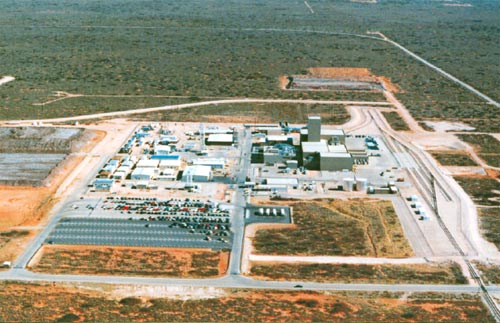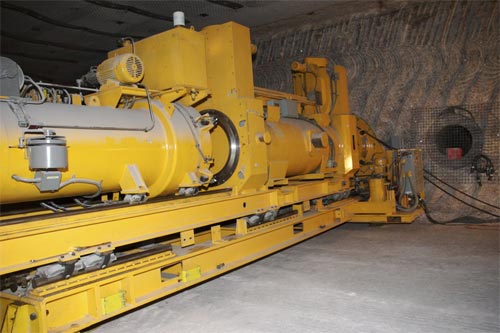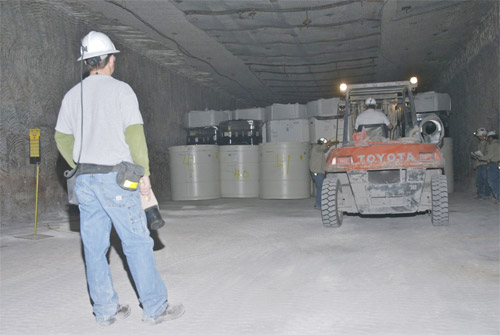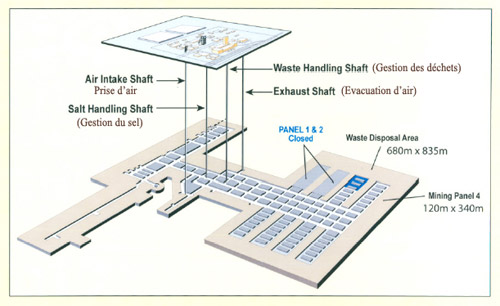The world’s first deep geological repository

Above-ground facilities at the Waste Isolation Pilot Plant (WIPP)
The Waste Isolation Pilot Plant (WIPP) is a repository for military and research-related radioactive waste located in Carlsbad, in a desert area of south-eastern New Mexico. The facilities cover 14 hectares of a sprawling 4,144 hectare site. The US Department of Energy has been operating the facility since March 1999.
© WIPP/DOE
The United States is the first country in the world to have begun operating a deep geological repository for radioactive waste. The Waste Isolation Pilot Plant (WIPP) in Carlsbad, in south-eastern New Mexico, is currently the only underground waste disposal facility of the type in existence. This depot for military transuranium waste (TRU in US nomenclature), excavated in a deep-lying salt formation, entered service in 1999.
Defence-related TRU waste is so named because it is from materials that have been contaminated with plutonium isotopes. It includes protective clothing: coveralls, gloves, shoe covers, etc. Other sources include, dismantled machine tools, workshop demolition rubble and sludge contaminated with radioactive substances from US nuclear weapon plants.
In order to manufacture the US arsenal of thousands of plutonium-containing nuclear weapons, dozens of tonnes of this heavy transuranium element (thus described due to its position after uranium in the periodic table ) were synthesised and then machined. From a radiation protection perspective, plutonium and the other transuranium elements are alpha emitters, and radiotoxic if ingested. They have long half-lives.
) were synthesised and then machined. From a radiation protection perspective, plutonium and the other transuranium elements are alpha emitters, and radiotoxic if ingested. They have long half-lives.
Under the French system, the waste at WIPP would be classified as intermediate-level, long-lived waste (ILW-LL). Under federal law, WIPP is not licensed to accept high-level waste or spent nuclear fuel intended for disposal at the Yucca Mountain repository in the Nevada desert.
WIPP is located in a sparsely-populated desert area. Waste is disposed of in salt domes. The salt formations, the top of which lies 305 m below the surface, are 650 m thick. Salt is considered to be a good medium for repositories, as it is free from water. The geology of the salt formations at the WIPP has been stable for 200 million years. The facilities are located 635 m below the surface. They include four shafts and 10 waste disposal areas.

Placing “Remote-handled TRU” waste
More highly radioactive transuranium (TRU) waste requires remote handling and is named accordingly (remote-handled transuranic waste). Special-purpose Horizontal Emplacement and Retrieval Equipment (HERE) is used to push packages into disposal cells excavated into the walls of a disposal cavern.
© WIPP/DOE

Placing “contact-handled TRU” waste
The least radioactive TRU waste may be handled with no need for special-purpose equipment. A technician responsible for radiation monitoring keeps a close eye as contact-handled transuranic waste is placed in the depths of the WIPP repository.
© WIPP/DOE
Two types of placement are used, depending on the degree of radioactivity of the waste packages concerned. If the level of gamma emissions is high, waste is placed by a remote handling system. If the level is low, waste is placed directly, by “contact handling”.
The Department of Energy (DOE), which operates the facility, is licensed to dispose of up to 173,600 m3 of TRU waste from National Defence-related activities. The repository is designed to operate until 2070. By the end of 2005, after six years in operation, the site was 20% full, with no reports of radioactive environmental releases or worker contamination.
Two incidents occurred at the WIPP facility in February 2014, including a truck fire. The US Department of Energy authorized the WIPP restart in late 2016, after confirming the absence of significant impact outside the installation. All necessary corrective measures have been taken, including a safety review. The lessons learned from this event were taken into account in France in the design of the CIGEO project.

Underground facilities
The underground repository facilities are laid out on a plane at a depth of approximately 650 m. Four shafts provide access to the repository: two air intake and venting shafts, one for mining activities and salt raising, and one for waste lowering and management activities.
© WIPP/DOE
The National Defence argument undoubtedly played a role in surmounting the many procedural obstacles that had to be overcome before the site opened. Twenty years elapsed (1979-1999) between the initial license granted for WIPP by Congress and the final operating license issued by the New Mexico Department of the Environment.
Other articles on the subject « Geological disposal »
Waste duration
Nuclear spent fuel and vitrified waste: what legacy? “Much of this nuclear waste will remai[...]
CIGEO project
CIGEO – Overview of a planned repository The efforts made by engineers to ensure that highl[...]
Clay medium
The Callovo-Oxfordian argilite The geological stratum or ‘host rock’ that will[...]
Bure underground laboratory
A research laboratory for a disposal facility site Before high-level radioactive waste is buried [...]
Results on deep clay disposal
What we know about the disposal facility site In its final report in 2006 the French National Ass[...]
High-level waste repositories
Disposal of high-level waste packages The high-level waste packages requiring disposal will proba[...]
ILW-LL waste repositories
Filling an intermediate-level waste disposal cell Intermediate-level (ILW-LL) waste releases litt[...]
Waste disposal USA
Back to the drawing board after Yucca Mountain WIPP, the first deep geological repository to begi[...]
Waste disposal Sweden
Sweden and Finland – Exemplary waste management Sweden probably features among the E[...]
Other countries
Shared challenges and similar solutions In most countries with nuclear industries, solutions for [...]